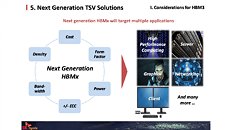- Joined
- Oct 9, 2007
- Messages
- 47,690 (7.42/day)
- Location
- Dublin, Ireland
| System Name | RBMK-1000 |
|---|---|
| Processor | AMD Ryzen 7 5700G |
| Motherboard | Gigabyte B550 AORUS Elite V2 |
| Cooling | DeepCool Gammax L240 V2 |
| Memory | 2x 16GB DDR4-3200 |
| Video Card(s) | Galax RTX 4070 Ti EX |
| Storage | Samsung 990 1TB |
| Display(s) | BenQ 1440p 60 Hz 27-inch |
| Case | Corsair Carbide 100R |
| Audio Device(s) | ASUS SupremeFX S1220A |
| Power Supply | Cooler Master MWE Gold 650W |
| Mouse | ASUS ROG Strix Impact |
| Keyboard | Gamdias Hermes E2 |
| Software | Windows 11 Pro |
One of the first drafts of the HBM3 specification reveals that the standard could enable graphics cards with up to 64 GB of video memory. The HBM2 memory, which is yet to make its consumer graphics debut, caps out at 32 GB, and the first-generation HBM, which released with the AMD Radeon Fury series, at just 4 GB.
What's more, HBM3 doubles bandwidth over HBM2, pushing up to 512 GB/s per stack. A 4096-bit HBM3 equipped GPU could have up to 2 TB/s (yes, terabytes per second) of memory bandwidth at its disposal. SK Hynix, one of the key proponents of the HBM standard, even claims that HBM3 will be both more energy-efficient and cost-effective than existing memory standards, for the performance on offer. Some of the first HBM3 implementations could come from the HPC industry, with consumer implementations including game consoles, graphics cards, TVs, etc., following later.

View at TechPowerUp Main Site
What's more, HBM3 doubles bandwidth over HBM2, pushing up to 512 GB/s per stack. A 4096-bit HBM3 equipped GPU could have up to 2 TB/s (yes, terabytes per second) of memory bandwidth at its disposal. SK Hynix, one of the key proponents of the HBM standard, even claims that HBM3 will be both more energy-efficient and cost-effective than existing memory standards, for the performance on offer. Some of the first HBM3 implementations could come from the HPC industry, with consumer implementations including game consoles, graphics cards, TVs, etc., following later.

View at TechPowerUp Main Site








